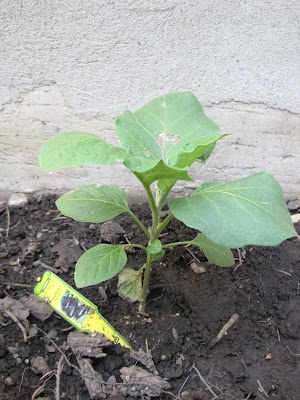1) Plant flowers next to squash, and pumpking plants in order to ensure fertilization. I had to pollinate a lot of my pumpkins and squashes this year because I lacked bee power! I noticed that the bees were all hanging out in my front yard where I have a lot of native flowers which they love. Next year My pumpkins will be planted next to four Russian sages...bees love these bushes. I am also planting my squash by my roses. I was thinking it may help keep the weeds down and the squash will benefit from all of the bees attracted by the roses.
2) Do not plant three habanero plants unless you want hundreds of habaneros! I did not realize how many habaneros you can get off of one habanero plant! I just couldn't keep up. I did have the right amount of Jalapenos which was two plants. I made two types of salsa, one I'm afraid to try but I know my husband will love it because it my be capable of burning your tongue off. Another side note on very hot peppers....especially Habaneros..always wash your hands after harvesting, or wear gloves. If you rub your eyes after picking these peppers you will be very uncomfortable!
3) Corn needs to be planted ASAP! I planted mine a bit late this year, I was able to get corn but not as much as I would have liked.
4) Don't plant a bunch of radishes unless you really like them! They grow super fast almost like weeds and if you leave them in the ground too long they wont taste very good.
5) Make sure you trim your tomatoes and don't let them get out of control! I did not realize how fast a tomato plant can take over! I learned, a little late in the game, that a tomato plant needed to be kept in check. If you don't do this then the plant ends up spending all sorts of energy growing big and bushy and not so much on growing big a juicy tomatoes. My tomato garden turned into survival of the fittest. I had a yellow pear tomato plant that pretty much took over the area and ended up stunting the growth of one of my Roma plants. Next year I plan on growing mostly Roma tomatoes because they are the tastiest in sauces, and even though I love me a fresh garden tomato, I just can't eat enough of them to justify growing all those heirloom plants. I love salad......but not that much.
6) garlic should be planted in the fall...I was able to get a few bulbs this year but they weren't very big.
All and all I felt my garden was pretty successful, the plants I enjoyed watching grow the most were; eggplant, pumpkin, and peppers. I've also learned that there are many different ways to use peppers in my cooking and I have enjoyed the adventure of it all.
Now my garden looks a bit barren..and it is cold and rainy outside. I started a compost pile this year but it wont be ready until next harvest to put on the garden. I plan on cheating this year and buying some good soil to add to my garden. This fall I also planned next years garden so hopefully it will be a bit more organized.
I planted my garlic in the middle of October...of course we had a warm spell (Utah weather can be a bit unpredictable) Some of the garlic sprouted but I'm hoping all still goes well in the spring. If not, I will plant my garlic a bit later in the year.
 I also harvested my herbs and hung them to dry. starting from the left I have; Thyme, Purple sage, Oregano, Rosemary, Mint, and Peppermint. I will be storing the Mint and Peppermint together so I can drink it as a tea.
I also harvested my herbs and hung them to dry. starting from the left I have; Thyme, Purple sage, Oregano, Rosemary, Mint, and Peppermint. I will be storing the Mint and Peppermint together so I can drink it as a tea.I am going to take a break from this blog and work on another blog which will just be my baking adventures. At first I was going to just keep it all on this blog but I fell it will be more organized if I separate the two.
See you next spring!

























































